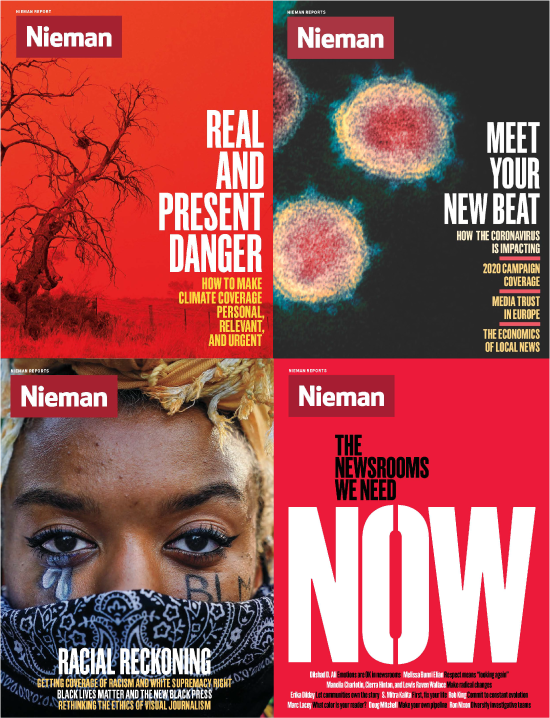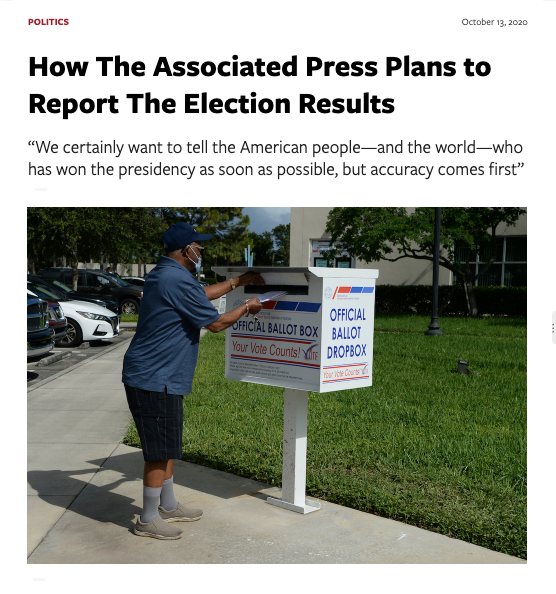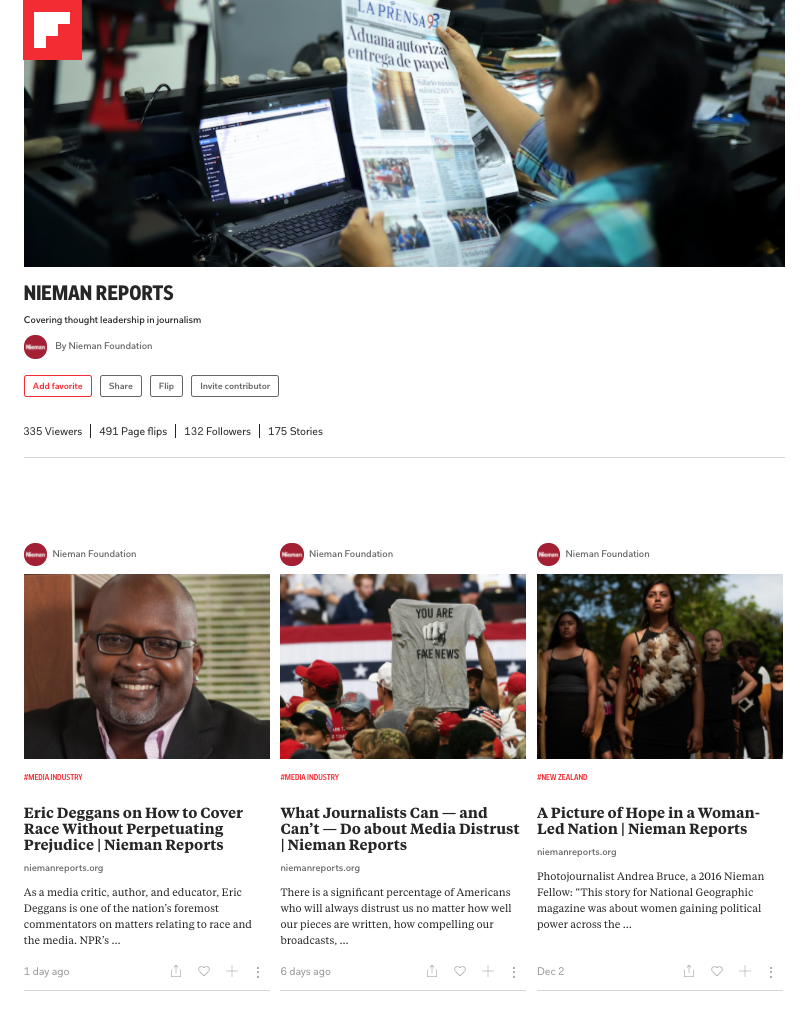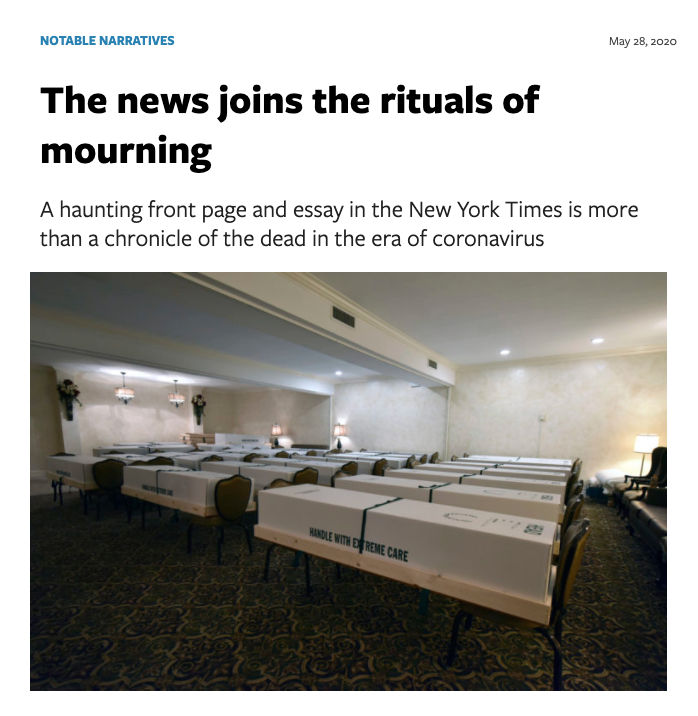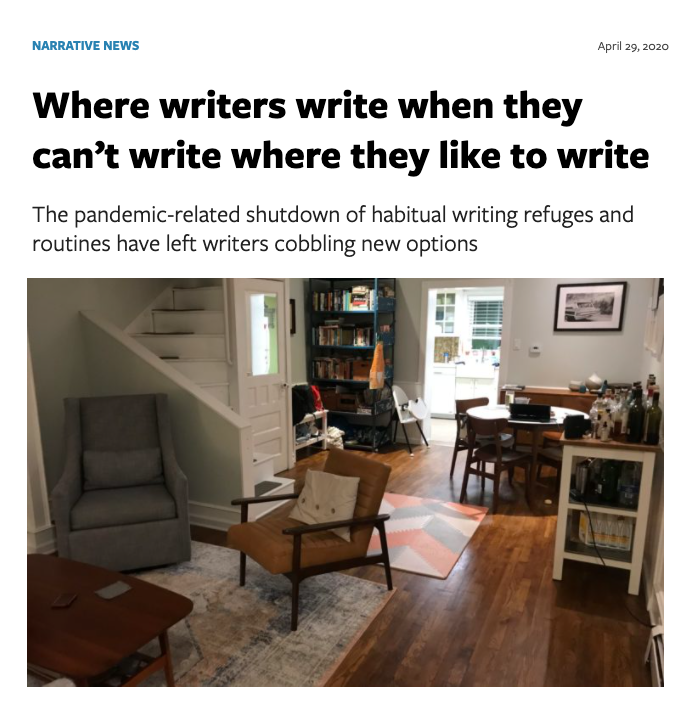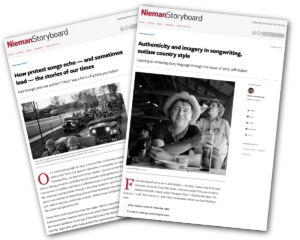Publications
Nieman Reports
 Nieman Reports has been covering thought leadership in journalism since 1947. In 2020, it published timely, insightful and deeply researched analyses of, and commentary on, issues pertinent to the media industry, including in-depth looks at how newsrooms are responding to the challenges of the coronavirus and the country’s racial reckoning. This work appeared in four 2020 print issues as well as more than 70 online-only pieces featured on niemanreports.org.
Nieman Reports has been covering thought leadership in journalism since 1947. In 2020, it published timely, insightful and deeply researched analyses of, and commentary on, issues pertinent to the media industry, including in-depth looks at how newsrooms are responding to the challenges of the coronavirus and the country’s racial reckoning. This work appeared in four 2020 print issues as well as more than 70 online-only pieces featured on niemanreports.org.
Cover packages from this year’s print issues focused on coverage of the climate crisis (Winter 2020), the coronavirus pandemic (Spring 2020), the racial justice movement (Summer 2020) and how the news industry is responding to the social, racial and political challenges it currently faces (Fall 2020). The latter topic was covered in the “The Newsrooms We Need Now” series, which featured essays by thought leaders reflecting on the ways that — beyond making newsrooms more diverse — news organizations can change structures and cultures that perpetuate racial inequity. Contributors included New York Times national editor Marc Lacey, Futura CEO and 2020 Knight Visiting Nieman Fellow Erika Dilday, S. Mitra Kalita, formerly with CNN, The AP’s Ron Nixon, and many more.
Other highlights from the 2020 print issues include articles on refugee journalists, how journalists are managing their mental health in this unprecedented time, a look at movement journalism, the push for pay equity in newsrooms, how independent journalists in Latin America are finding new ways to hold power to account, the rise of audio articles, ways to fund and save local journalism, how speculative journalism can help us prepare for what’s to come, the ways historians and journalists are teaming up and much more.
Online, Nieman Reports published pieces about how journalists around the world are responding to the coronavirus — how they’re covering it and how it’s impacting their newsrooms and livelihoods. Along with looks at situations in specific countries, such as Hungary, South Africa and Nicaragua, pieces included a look at how coronavirus coverage has impacted trust in news outlets in Europe, the role newsrooms should play in debunking COVID-19 misinformation and why responsible predictions are essential to fully informing the public in a pandemic.
Nieman Reports provided extensive coverage in the run-up to the 2020 presidential election. Newsroom leaders and political reporters — from local and regional newspapers like The Detroit Free Press and The Atlanta Journal Constitution; online-only outfits like Votebeat; and international wire services AP and Reuters— shared how their newsrooms were preparing to cover election day and its aftermath; additional pieces reported on what to expect from national outlets and cable news.
Nieman Reports also published online-only opinion and commentary pieces on topics ranging from the arrest of 2010 Nieman Fellow Hopewell Chin’ono and what that says about the state of the free press in Africa to pieces on the state of objectivity in journalism, how newspapers can build digital reader revenue and much more.
Using its old newsletter mailing list, Nieman Reports created a new monthly newsletter in April 2020 that now reaches more than 6,200 subscribers. It also has seen major growth in users referred from social media and search engines. Compared to the same Jan. 1 to Nov. 14 period of last year, users referred from search have grown by 40% and users referred from social media have grown by 52%.
A totally new audience has been reached via Flipboard, resulting in 13,325 new users to the Nieman Reports website. The overall pageview traffic of niemanreports.org grew 43% in 2020 compared to the previous year. The Nieman Reports Facebook account reached 6,615 total likes and 6,709 total followers, while Twitter followers increased to 33,280.
In 2020, Nieman Reports was the winner of the 2019 Bart Richards Award for Media Criticism. Nieman Reports last won the award in 2014.
The staff that produces Nieman Reports includes editor James Geary, deputy curator of the Nieman Foundation; senior editor Jan Gardner; editorial specialist Eryn Carlson; and publisher Ann Marie Lipinski, curator of the Nieman Foundation. Print design is by Dan Zedek.
Nieman Lab
For the past 12 years, the Nieman Journalism Lab has provided incisive coverage of the future of news, innovation and best practices in the digital media age. The Lab is an essential resource serving a worldwide audience of loyal readers and industry analysts looking for original reporting, research and commentary on the rapid evolution of digital. It is the global “paper of record” for journalism innovation
In 2020, Nieman Lab continued to provide valuable and innovative daily coverage of the ever-changing world of digital news. In July, Laura Hazard Owen became the editor of Nieman Lab and Lab founder Joshua Benton took on the role of senior writer. Staff writers are Sarah Scire and Hanaa’ Tameez.
The Lab’s goals remain to help reporters and editors adjust to their online environment; to help traditional news organizations find a way to survive; and to help the new crop of startups that are increasingly complementing or supplanting those outlets. It sees racism and outdated standards of journalistic “objectivity” as innovation issues as well as moral ones and, in 2020, moved to cover these issues regularly, syndicating The Objective’s biweekly newsletter on communities that journalism in the U.S. has typically ignored.
The Lab’s most important social outreach platform remains email, with the daily and weekly email newsletters reaching over 80,000 people. The Lab’s other social accounts on Twitter, Facebook and LinkedIn continued to see steady growth in 2020, with nearly 500,000 followers between them. Nieman Lab’s Twitter account surpassed 300,000 followers this year; its top tweet, a thread of journalists of color talking about the racism and discrimination they’ve faced while working in newsrooms, was shared more than 2,000 times.
For a taste of what Nieman Lab does, here is a sampling of the stories published this year: A map of hyperpartisan publishers posing as local news sites; an investigation into how much political news Facebook users actually see; an interview with New York Times CEO Meredith Kopit Levien, the youngest CEO in Times history; a story on how ProPublica is making its articles more accessible to people with disabilities; a call to change the way the media reports on protests; a piece on why COVID-19 could spell the end for alt-weeklies; a profile of Prism, a news site led by women of color; a look at why Google is giving so much money to news publishers; and multiple stories on the bankruptcy of McClatchy and what it spells for the history of newspaper chains.
Among the major questions the Lab explored in 2020: How has the pandemic affected the types of news people consume and the information they trust—and what has its financial impact been on publishers? What’s the best way to cover the U.S. presidential election, and how should news outlets handle polling data? How will news organizations keep their promises to become more diverse and inclusive? How should Twitter, Facebook and YouTube moderate news content on their platforms?
The year ended, as it has each year since 2011, with a collection of predictions for the new year in journalism, written by a diverse group of smart digital thinkers and doers. It remains one of the most anticipated editorial products of the year in news industry circles.
The Lab has continued to commit significant resources to reporting on the rise of misinformation and disinformation, with the “Real News About Fake News” column essential reading for those interested in the topic. This year, COVID-19 and the U.S. presidential election provided ample opportunities for breakout pieces and coverage of cutting-edge research. The Lab also entered a publishing partnership with the misinformation nonprofit First Draft, further strengthening its coverage of these topics.
Nieman Storyboard
No journalistic venture has been immune from the stresses of COVID-19 this past year. Although Nieman Storyboard works a few steps removed from primary news coverage, journalism related to the pandemic featured in at least 30 posts since the coronavirus became big news in February.
The choice of those featured stories ranged from a surprising personal story by Dan Barry of The New York Times about moving his father-in-law out of a rehab facility to avoid being isolated during the shutdown, an explanatory piece by Ed Yong of the Atlantic (who has arguably become the clearest voice writing on the science of pandemic), a meditation on the societal value of obituaries by Roy Peter Clark, a fun collection by Matt Tullis of where writers write during the shutdown and a stunning piece by Katie Englehart for California Sunday Magazine reported by phone that took readers “inside” the Seattle area nursing home that became the nation’s first COVID hotspot, which no doubt will be a National Magazine Award contender.
Posts in 2020 featured a similar range of stories that touched on other big news: wildfires sweeping through the West, the mayhem and divisiveness of national politics and street demonstrations protesting police violence and racial injustice.
The frequency of those posts underscores that Storyboard’s focus on the art and craft of literary journalism is responsive to the stories that reflect the times we find ourselves in, and to the reporting and writing demands of those stories. Interviews, annotations and analyses have provided guidance on the challenges of reporting narrative remotely, the need to build writing habits outside the newsroom and the ethics of reporting on sensitive subjects like race and death.
Storyboard posts also have mirrored the cutbacks that continue to stalk the journalism industry. The site featured work from or about journalists who found themselves working in severely contracted newsrooms, in struggling start-ups, on their own as freelancers or in different professions altogether. The emphasis is not on the business and technological shifts in the industry, but—consistent with Storyboard’s mission—on pieces that provide tools or inspiration for journalists.
The constancy of this shift inspired a new feature on Storyboard: “The Pivot,” proposed by regular contributor Julia Shipley, is a continuing series of interviews with journalists from all corners of the profession who find their careers disrupted. The foundational questions probe how they worked through a major transition, where they landed and what lessons—both personal and journalistic—they carried with them.
Another strong support feature has been the revival of “The Pitch,” the site’s occasional series of interviews with editors about what they look for in a strong story pitch, and annotations of pitches that worked. The constant request for more, more, more on pitching also prompted a limited series on the “7 Fatal Flaws of Pitching.” The advice may seem a bit remedial, but editor after editor points out these basic mistakes as ones that undermine a writer’s ambitions.
Working closely together, Storyboard editor Jacqui Banaszynski and Nieman audience engagement editor Leah Becerra instituted changes that have continued to boost Storyboard’s reach and build more multimedia capability into posts. Audio and video are being added to articles more often, as in this tribute to the storytelling genius of singer-songwriter Jerry Jeff Walker. The Storyboard team is also working on ways to annotate podcasts, and a five-part series on learning to tell stories through short video documentaries will come in 2021. These changes have led to a significant and sustained uptick in traffic to the site. From Jan 1. to Nov. 30, 2020, site page views increased by 7.7% compared to the same time frame in 2019.
Publishing earlier in the day and submitting RSS feeds to Flipboard, a popular newsreader app, helped contribute to Nieman Storyboard’s page view growth. So did a new social media strategy that emphasized regular posts during peak engagement hours on platforms like Facebook, Twitter and Instagram. Users referred from social media have grown 32% so far in 2020, compared to the previous year.
Banaszynski’s weekly newsletter, which is sent each Friday afternoon, grew and now reaches a total of 13,734subscribers. On Facebook, Storyboard’s account reached 5,517 followers and 5,422 total likes, while on Twitter, followers increased to 16,145.
Future goals for Storyboard include:
- Continuing the focus on the journalistic challenges posed by new reporting demands (technology, distance work, industry instability), with tools and advice about how to meet those challenges.
- Expanding the focus on multimedia of all kinds, including nonfiction storytelling that isn’t technically considered journalism.
- Finding ways to identify and feature good work being done throughout the profession. The contraction of the industry and the demands on shrunken newsrooms have made The New York Times, The Washington Post and The Atlantic overly dominant voices in our work.
- Working with a greater diversity of voices from all media platforms and communities.
- Finding creative ways to identify and emphasize the incredible strength of journalism being done. Despite the stresses, there is no question that the best of today’s journalism is better than it’s ever been. Storyboard wants to find ways to demonstrate and honor that.

